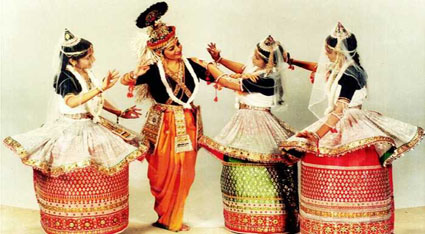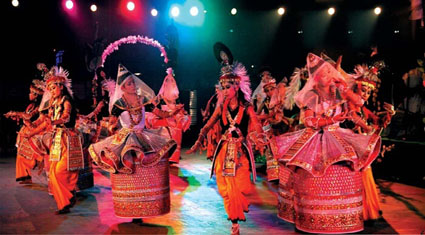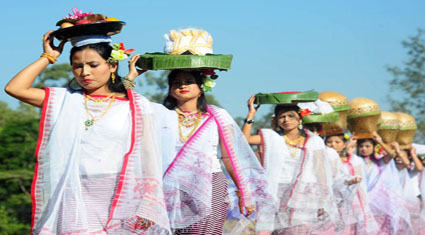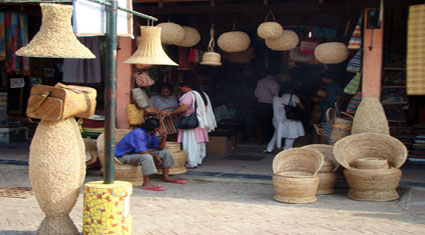Manipuris takes the pride of a rich cultural heritage. The people of Manipur strongly adhere to their customs and religious belief and are very superstitious. The Manipuris are peace loving with lot of creativity and very artistic in nature which is exhibited in their handloom and handicrafts. The people of Manipur celebrate lot of fairs and festivals which is always accompanied by vibrant dances and music. Though the people of Manipur are divided into a number of colorfulsects of people like Meitei, Naga, Kuki, Meitei Pangal, etc, they still in harmony with their own unique culture and traditions. Each one strictly adhere to their customs and faith and stillrespect people and their beliefs from other communities or religious sects. The socialstructure of the people of Manipur is mainly built by their religion. Manipur being predominantly occupied by the tribal people, they have a strong belief in supernatural power that organizes and animates the material universe and thus their customs is molded out of superstitions.
The Manipuris are supposed to be pure vegetarians but still there is no restriction of fish in their food. Rice along with fish and vegetables are the staple food of the Manipuris.Fruits and milk also constitute a daily part of their meal. The Manipuris love fish and the preparation of the Ngrifish by fermenting is one of their favorite dishes. Mostly the fish is prepared along with potatoes and it is a part of their daily recipe made with fish. Some of their most common and liked food includes nga-thongba (fish curry), ooti(a typical Manipuri vegetarian dish), chagem pomba (made with fermented soya, mustard leaves) and Chamthong or kangshoi, which is a stew cooked with seasonal vegetables. Erolpa, Paltoi, Chhinchou, Maroi-jhool are some of their traditionalfood prepared in a unique way.Lonchak is one of their favourite vegetable bean. The Bishnupriya Manipuris abstain themselves from meat, egg and any kind of wine. Kabok, a traditionalspecialty, is actually fried rice with lots of vegetables.
. 
|
|
Innaphi and Phanek are the most common Manipuri traditional dress for women. The people also weave a special Phanek called Mayek Naibi where the designs on Naibi are horizontal stripes making it look beautiful. The Meitai Females stitch a cloth which called Kanap Phanek which has various designs on it. 'Lai-Phi' and 'Chin-Phi' are other Manipuri traditional costume. The white turban called Pagri is the most common among men. When the kings ruled the land, Khamen Chatpa were gifted to poets and geniuses. Even now, Khamen Chatpa is worn by men belonging to the superior class. Nowadays with modernization taking over traditional culture, the people wear the traditional dress only during festivals or rituals.

|
|
Lai Haraoba Ishei is a song which is known for erotic mysticism, but the inner meaning is covered up by the use of simple words. It is sung during the ceremonial occasion of Lai-Haraoba. Thoubal Chongba, Nat, Gaur Padas, Dhob, Napi Pala, Khubaishei, and Raslila songs are some of the many famous songs sung in that region.
For the Manipuris, dance is an integral part of the culture, and for the audience, it’s a visual treat due to its lyrical beauty and rhythm. History says that King Khuyoi Tompok was a great lover of art and culture and developed Manipuri dance in the 2nd century AD. After the introduction of Vaishnavism in the 15th century, the dance form started becoming familiar and very common. It is said that the dance form found expression outside Manipur culture by the efforts of Rabindranath Tagore.

|
|
Manipur hosts numerous festivals; some of the major ones are Dol Jatra (Yaoshang ), Rath Jatra, Lai-Haraoba, Ramjan ID, KUT, Gang-Ngai, Chumpha, Cheiraoba, Heikru Hidongba, Lui-Ngai-Ni, and Kwak Jatra.
In Lai-Haraoba, the festival is celebrated in the name of the deity called Umang Lai which takes place in May. Kut festival is celebrated by the Kuki-Chin-Mizo groups of Manipur. It takes place on 1st November in honor of an abundant harvest. Gang-Ngai is a festival lasting five days. It starts with the omen taking ceremony which is later continued with dance and feast. Cheiraoba is the Manipur New Year which takes place in April. As part of the traditional belief, the villagers climb the nearest hill which helps in bringing good fortune. Yaosang is like the festival of Holi which is considered the most important festival in Manipur. The locals take part in the celebration of merrymaking. Recently, the festive energy is directed towards sporting events to identify talents at the ground zero level.

|
|
The people of Manipur mostly live as joint family and they follow the patriarchal pattern ofsociety. The right to inherit the property and the family name is taken by the direct blood relationship. In the patriarchalform ofsociety the father is the head and the mother takes an honorable place. Once the father dies the entire responsibility of the family falls on the eldest son. When it comes to the partition of the property all the sons are entitled to an equalshare. The women of the family or the mother sometimes though treated in par with the male cannot stake their claim for a share of paternal property whereas a women after the death of her husband can inherit the husband's estate. The traditional house of the Bishnupriya Manipuris are called as the Inchau which are mainly constructed on plane lands. Wood and Khapak are mainly used in the construction of the house fenced by a kind of hemp plant. Though there are modern houses coming up but still people beonging to the orthodox Bishnupriyas follow to build their houses with the traditional pattern.

|
|
It's not surprising that northeastern states have people who are into the creative business and their craft is very different than the rest of the country. It is said to be one of the largest producers of bamboo crafts in India and many decorative items like sofa sets, stools, mats, basketry and flower vases are made. Kauna is a kind of reed this is used for making mats and cushions and often exported to countries like UK, Netherlands, Germany, France, UAE and Switzerland.Pottery is an age-old craft of Manipur which is painted in different and bright colours. Textile Weaving is practised by the women and also known as Laichamphi.

|
|
